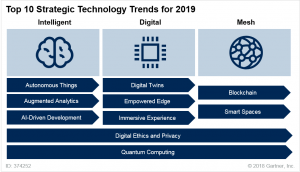Contents
The 10 most important trends for 2019
What is the common denominator for interaction, the cloud, the Internet of Things (IoT), Business Intelligence, data analysis, VR and nanotechnology? Everyone has been or is a technology development. Read about the trends used today and the trends you need to relate to in the coming years.
Over the past ten years, many new technologies have been added. The cloud is one of them, but according to a Gartner report from 2011, only 1 percent of the IT managers surveyed thought that cloud services would create strategic value for the business over the coming years. It was also only 1 percent who believed that solutions for mobile phones (apps and mobile sites) would have a strategic value for the company. And the answers came four years after Apple launched the iPhone.
Trends used every day
Right now, interaction, mobility, cloud services and video conferencing are used daily in most companies and industries. And the few companies that don’t use the technologies plan to use them. If you choose to abstain, you risk losing competitiveness.
Technology analysis companies such as Gartner, Forrester and IDC have their own ways of measuring technology maturity. Gartner has given us concepts such as “Magic Quadrant” and “Hypurcury” while Forrester has “Forrester Wave” and IDC has “IDC Tracker”. The analysis companies have developed the predictions of the future using various quantitative and qualitative methods.
A clear technological shift
Not all predictions are true. Many predicted that the computer would die out, as sales peaked in 2011 and then dropped when sales of smartphones grew year after year. But the traditional computer still lives, while sales of both smartphones and tablets have fallen in recent years.
But as mentioned earlier, mobile devices have taken over over the last ten years. In 2007, two computers were sold per smartphone. Ten years later, six smartphones or tablets were sold per computer.
As a rule, you are often too optimistic when it comes to technology, but you underestimate the power of the technology shift.
During the past four or five years, New Year’s Eve has predicted that “this will be one year for VR and AR”. But with a few exceptions, such as the use of AR in Pokemon Go, the major breakthroughs for these technologies have failed. In any case, when it comes to the population in general, but in several activities, both VR and AR can be used in a good and profitable way.
Continuous development
At the end of October 2018/19 Gartner started the season’s conference series ITxpo. “Continuous Next” is the year’s most important term, which can be translated into “continuous development”.
– The digital transition is inevitable and the press to become digital is increasing. Digitization changes how the public sector contacts citizens and changes business models within businesses, Mike Harris, head of advisory and research at Gartner, at ITxpo in Florida, began.
Harris emphasizes five different drivers that affect the digitalization of businesses:
Culture
Privacy
Digital product management and development
Mixture of Human and Artificial Intelligence (augmented intelligence)
Digital Twins
“Almost two-thirds of executives expect their business models to change in a short time,” Harris continues, revealing a new Gartner survey.
He emphasizes that it is technology that enables the changes and that digital transformation means that businesses must constantly change their business models.
– The technology increases the pace of continuous development. And if you want to be among the most innovative then you have to find a way of thinking and new ways of working that embrace eternal development. “Continuous next” is the strategy required to succeed in a constantly changing world, Harris adds.







